ASRock's High-End Vision 3D HTPC Reviewed
by Ganesh T S on October 3, 2010 10:20 AM EST
The Vision 3D is basically a notebook solution at its core. It wouldn't make sense to compare it with full blown Clarkdale HTPCs (or for that matter, any system with a power consumption of more than 100W). In the comparative benchmarks provided in the rest of this review, we will provide the scores obtained by the Vision 3D and other notebook solutions. Prior to those, let us look at some of the specific features of the Vision 3D.
USB 3.0 Performance
In the Core 100 review, we had pointed out the fact that the H55M chipset does not provide support for full USB 3.0 performance without a PLX bridge chip. As the Vision 3D caters to the high end market, it would have made sense for ASRock to incorporate this into the motherboard. Unfortunately, they decided to increase the number of USB 3.0 ports instead of aiming to obtain full performance from the pair of ports provided by the NEC controller.
We hooked up OCZ's Enyo 128 GB USB 3.0 external SSD (which has received glowing reviews everywhere with upto 200 MBps read and 190 MBps write speeds) to the various USB 2.0 / 3.0 ports of the Vision 3D (and also repeated the tests with the Core 100).
The OCZ Enyo on the Fresco Logic USB 3.0 Port of the Vision 3D
Using the Random Access feature of HD Tune Pro 4.50, we obtained the average read and write speeds for random sized accesses to random locations on the SSD. The performance metrics are graphed below. Note that the entries against the USB 3.0 ports of the Core 100 differ from those in the Core 100 review, because those were maximum transfer rates as opposed to the average rate presented here.
Click to enlarge
At the outset, it is clear that the USB 3.0 performance improves when compared with the Core 100. This is probably due to the faster i3-370M CPU. An additional interesting observation is that the read and write performance are very similar for the Fresco Logic port. The NEC ports excel at providing read bandwidth, but lose out to Fresco Logic on the write side. Despite these performance numbers, we feel that the third USB 3.0 port is an overkill for the Vision 3D. ASRock could have used the cost premium of this feature towards something more attractive for HTPC users like a SSD boot drive for the OS.
Windows Experience Index
The Core 100's Windows Experience Index was bottlenecked by the Arrandale iGPU. With that going out of the picture, what can hold back the performance of the Vision 3D? Let us look at the Windows Experience Index to get a general feel of the performance that a user can expect out of the machine.
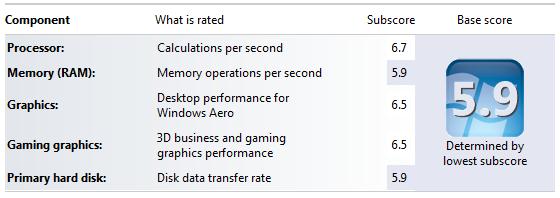
The primary hard disk and the DRAM seem to be slowing down the system. While the DRAM can be overclocked, nothing can probably be done with the primary hard disk (short of replacing it with a SSD). Unfortunately, the Scorpio Black is the fastest 500 GB 2.5" drive in the market right now, and ASRock could probably have not chosen a better drive.
Miscellaneous Performance Metrics
The graphs below give an idea of where the Vision 3D would stand from a performance perspective when compared with some popular notebook computers. PCMark Vantage's PCMark score gives a general idea of the system's capability. In addition to that, a couple of common HTPC workloads are also benchmarked. We have some data on the x264 encoding performance using the Arrandale CPU. An estimate of how well WinRAR performs, particularly with respect to processing split archives, wraps up this section. Since these are CPU-centric benchmarks, it comes as no surprise that the Vision 3D scores better than the
It can be seen from the above benchmarks that the Vision 3D loses out only to its higher clocked and higher core count cousins with respect to CPU-centric benchmarks. There is no doubt, however, that it provides better performance than the mid-range Core 100.
Starting with this review, we will add a WinRAR benchmark for HTPCs. While there is a built-in benchmark to measure the compression speed, it relies on the capabilities of the CPU, DRAM and caches only. Many HTPC users also spend quite some time decompressing split archives. To evaluate this, we take a 4.36 GB MKV file, compress it in the 'Best' compression mode into a split archive (97.1 MB each), which results in 44 files on the hard disk. The time taken to decompress this split archive is then recorded. The performance in this benchmark is heavily influenced by the hard disk in the system. While both the Core 100 and Vision 3D scored similar results in the built-in benchmark (1525 KBps for the Vision 3D and 1452 KBps for the Core 100), the former took 329 seconds to process the split archive, while the latter only took 173 seconds for the same. Starting with the next HTPC review, we will be presenting comparative results for this benchmark in the form of a graph.
In the next couple of sections, we will look at some GPU benchmarks.


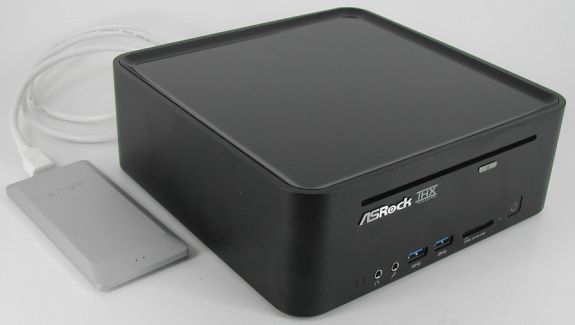
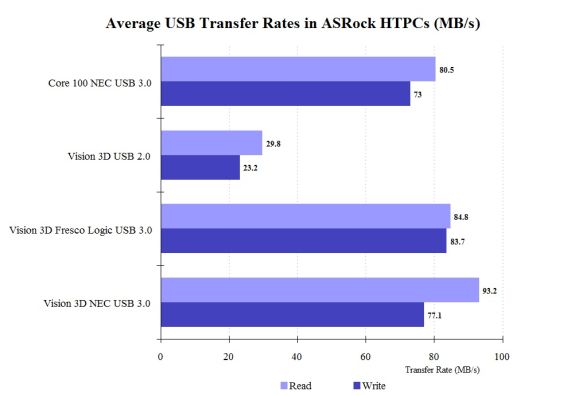
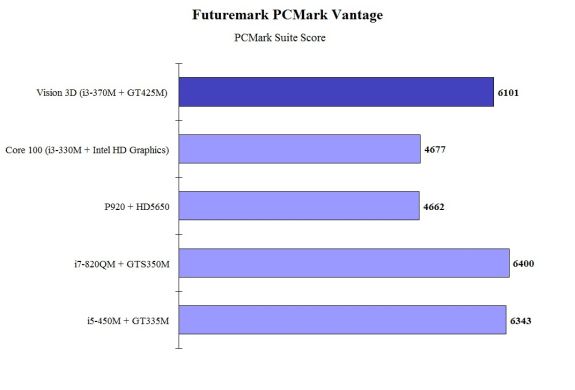
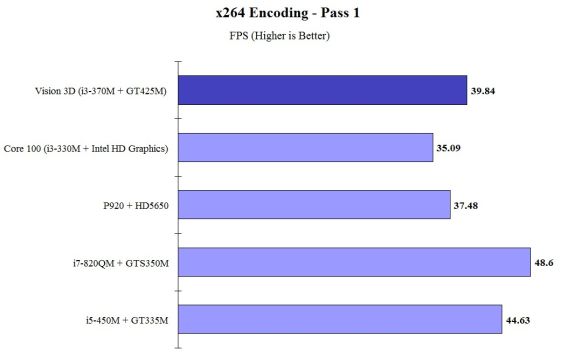
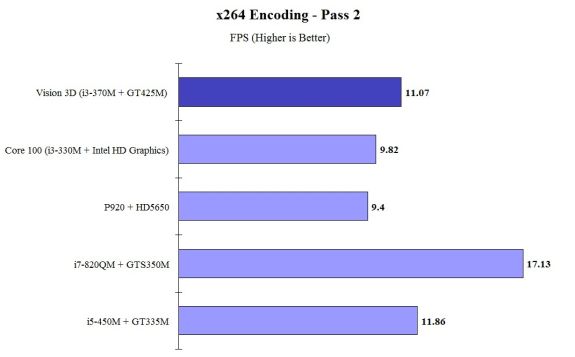








51 Comments
View All Comments
strolfey - Monday, October 4, 2010 - link
Thanks a bunch! Based on this, there's no major hangups so I'll be looking to get one as soon as it's available from newegg.cjs150 - Tuesday, October 5, 2010 - link
Bit like the Apple TV article, we are moving closer to the ideal living room HTPC but not there yet.A decent SSD rather than a HD would be better, less noise, reliability not an issue, less heat.
Noise is the issue for me. This is improving (and would be less noisy than my current cable box) but still not perfect (total silence would be perfect but impractical).
I do wonder whether an optical drive is really necessary. Seems to me that there may be 2 HTPC markets. One for a streaming device that can play games and another where the device is also the sole Blue-ray/DVD player on an AV system.
I would be happy to ditch the optical drive for a TV tuner. Even more so if it could replace the cable box
blacksun1234 - Wednesday, October 6, 2010 - link
Dear Ganesh,Is its BD playback video quality better than consumer BD 3D player?
ganeshts - Wednesday, October 6, 2010 - link
I didn't do a side by side comparison, but I would believe that you have lot more tweaks available at your disposal on the HTPC to do some post processing if you desire (compared to the options in a consumer BD 3D player).The only advantage of a consumer BD player I can foresee is the ease of use factor. HTPCs are inherently not designed to cater to the lowest common denominator yet. (Yes, we have Win7MC + PDVD / ArcSoft integration, but you still need to do some configuration like AutoStart / Start Maximized / configuration of 3D display etc. etc. to make sure it acts like a consumer BD 3D player).
SirMeili - Wednesday, October 6, 2010 - link
With my current HTPC, I can have distinct On and off Codes. so my question is this:You said you can wake the HTPC via the remote, but can you
1) put it to sleep with the remote, and
2) Turn the computer on with the remote (from an off state)
3) program additional codes for the IR Receiver (for instance, I have a button on my universal for alt-f4)
Neither are ultimately important, but I like my setup as it is now (especially since I can train specific on and off codes for my IR Receiver for the HP)
ganeshts - Wednesday, October 6, 2010 - link
1 and 2 are definitely possible ( 2, when AC power cord is still connected, but you already knew that :) )As for 3, I will ask ASRock. I haven't personally tried out.
The Jedi - Tuesday, October 12, 2010 - link
If this were an Asus brand product I might find it more attractive, but I think ASRock has issues with its reputation. I mean they make some innovative and low cost mobo's, but from reading around they seem to have quality control issues. Last time I visited their website they had imperfect English so I think I'll just stay away.mutarasector - Monday, November 29, 2010 - link
Can't wait to see a Llano powered version of this thing. I believe one might see a mini based on it by the 'Fruity computer Co.' in the not too distant future.borekb - Tuesday, February 1, 2011 - link
On these screen-less HTPC devices, how do you display things like MP3 or volume information while you're playing musing and the TV is turned off? I'm thinking about attaching a digital picture frame but would that be possible to output the signal to both HDMI (-> A/V Receiver -> TV) and to the frame? (I don't own any digital picture frame at the moment so I'm not sure what would be required on that front.)mpogr - Thursday, June 2, 2011 - link
Got one of these. They sell them here in Australia without memory and HDD, purchased both from the same store, the total price was ~940AUD (should be ~970-980 USD now)..Assembly was quite easy and all was working fine at first. Installed Windows 7 Ultimate 64 bits, SageTV client and PowerDVD 11 (planned primary use: TV and, occasionally, 3D Blu Ray playback). Because of TV being used by the children, the computer was always on (but not always playing back media). The unit died after ~5 days. I wasn't at home when this happened, but it just powered itself off. After that, upon disconnecting and reconnecting power, it came on and then off straight away. Resetting CMOS and pulling the BIOS battery out helped a bit, so now it doesn't power itself off after reconnecting the mains. The blower spins and the power led is lit, but no video output and no HDD activity. Disconnecing HDD and ODD didn't help.
So it's just dead. It can be the unit itself or the memory, as I don't have any spare SODIMMs to test. About to send the unit back to the retailer for investigation.